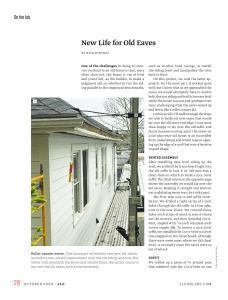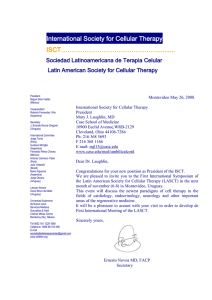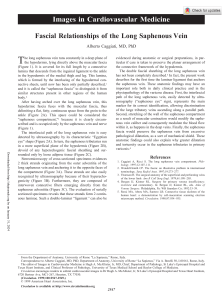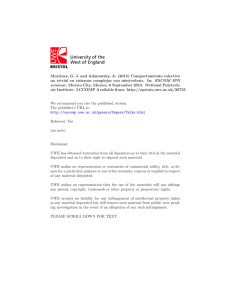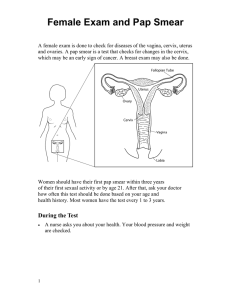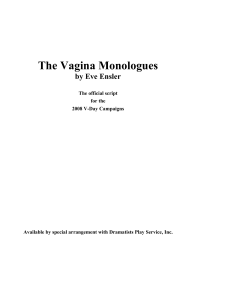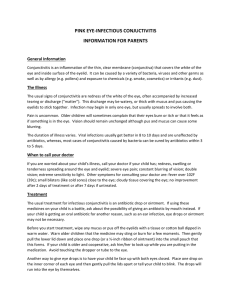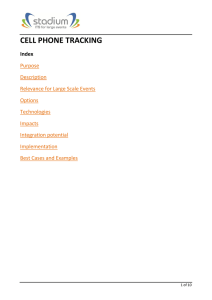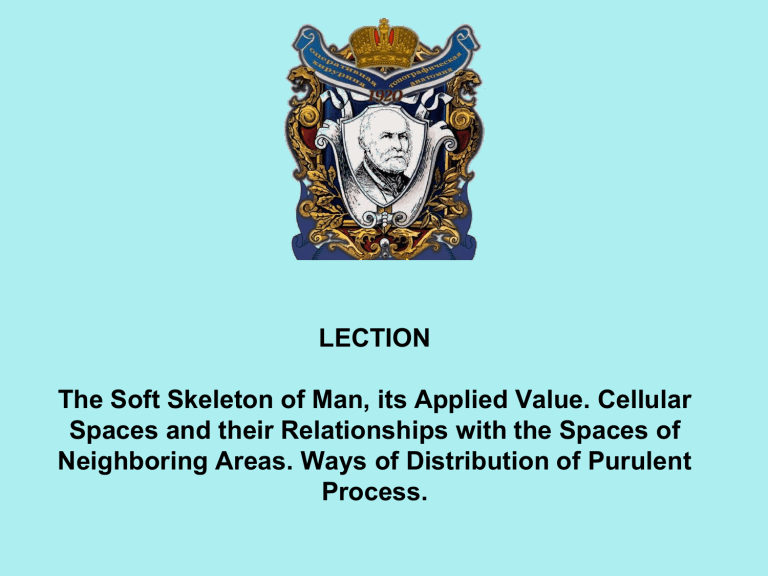
LECTION The Soft Skeleton of Man, its Applied Value. Cellular Spaces and their Relationships with the Spaces of Neighboring Areas. Ways of Distribution of Purulent Process. I. P. M a t u s h e n k o v. Soft skeleton of the human body or the total system of fibrous-cellular spaces of tissues. MSU archive, the case of the medical faculty № 24 for 1848 " on the exam for the degree of doctor of medicine Matushenkov.” and surgery medico-surgeon Professor N. K. Lysenkov Andreas Vesalius Professor P. F. Lesgaft Professor N. I. Pirogov "Surgical anatomy of arterial trunks and fascias", Saint Petersburg, 1837. Academician V. V. Kovanov Academician V. V. Kovanov, Professor T. I. Anikina Professor I. D. Kirpatovsky "Fascias and cellular spaces of the foot", Kand. Thesis, M., 1954 Professor V. F. Voyno-Yasenetsky Archbishop Luka of Simferopol and Crimea Professor V. K. Gostishchev (in center) Academician V. I. Struchkov FASCIA (Lat.«fascia» – ribbon, bandage) is a sheath of dense fibrous connective tissue covering the muscles, blood vessels, nerves, some internal organs. TYPES OF FASCIA 1. Surface 2. Propria 3. Muscular 4. Organ 5. Intracavitary SUPERFICIAL FASCIA (SYN. The saphenous fascia) - is a thin fascia, the superficial component of the fascial covering of the body, closely associated with subcutaneous adipose tissue, forming the skeleton located in the subcutaneous layer blood vessels, nerves, lymph vessels and nodes. PROPRIA FASCIA (fascia propria) - a dense fascia that covers the muscles of the topographic and anatomical region and forms a fascial bed for muscle groups. MUSCLE FASCIA — fascia covering the individual muscle and its fascial forming a vagina. ORGAN FASCIA — visceral fascia that covers the internal body and having its fascial sheath INTRACAVITARY FASCIA (fascia coelomic type) — fascia that lines the inside wall of the body cavity; secrete intracutaneal, intrathoracic, intra-abdominal, intrapelvical fascia. FIBER is a layer of more loose (compared to fascia) connective tissue that contains different number of fat cells. Subcutaneous fat is located throughout the surface layer of the human body under the skin. Visceral fiber cellular spaces fills the gap between the internal organs (muscles, vascular-nervous formations) and their fascial sheaths. Megfelelne fiber fills the cellular spaces of the space between the fascial sheaths of the anatomical structures TYPES OF FASCIAL AND INTERFASCIAL CONTAINERS 1. Fascial cases (bone-fibrous cases) 2. Fascial vaginas (a) muscular b) tendons с) vascular-nervous 3. Cellular spaces 4. Cellular fissure FASCIAL LODGE is a receptacle for a group of muscles formed by its own fascia, its intermuscular and deep plates. BONE-FIBROUS LODGE - fascial box, in the formation of which takes part, in addition to its own fascia and its spurs, periosteum bone. CELLULAR SPACES (spatium cellulosum, textus cellulosus ) is a large accumulation of tissue between the fascia the same or neighboring areas. FASCIAL VAGINA - receptacle for muscle, tendon, neurovascular bundle formed by one or more fascia. Tendon vagina - fascial vagina surrounding the tendon. Muscle vagina - the fascial vagina surrounding the muscle. Neurovascular vagina - fascial vagina, and surrounding major blood vessel or neurovascular bundle. Cellular fissure is elongated in one direction or the flat space between the fascia of adjacent muscles, contains loose tissue Fascial Formations of Pirogov Sections of Hip and Shoulder Scheme Fascial Formations of the Limbs The Fascia of the Axillary Fossa and Thigh Organ and Intracavitary Fascia The Palmar and Plantar aponeurosis Aponeurosis m. biceps brachii (Pirogov aponeurosis) Subcutaneous Fat of Fingers and Toes I III II IV Bone-fibrous channels of the fingers and the cellular fissures of median fasciale-muscle case of hand Pirogov-Parona Cellular Space Fascia and Fascial Neck Receptacles Fascial knot (junction) – white neck line Subfascial Edema of the Shin Compartment Syndrome Panaritiums and Phlegmons of Hand ANATOMICAL WAYS OF DISTRIBUTION OF PURULENT PROCESSES 1. PRIMARY WAY non-destructive (melting) fascia at the fascial cases of certain muscles at the fascial cases of the muscle groups along the aponeurosis 2. SECONDARY WAY by destroying (melting) fascia Ways of distribution of pus in the areas of the fingers and hand Hidradenitis and Ways of Distribution of Pus in it Post-injection Abscess of the Gluteal Region Possible Ways of Distribution Pus from the Gluteal Region Ways of Distribution of Pus in the Abscesses of the Maxillofacial Region Purulent Leakages in the Areas of the Upper Limb, Shoulder and Thigh Purulent Leakages in the Areas of the Hip, Knee and Thigh REQUIREMENTS INCISIONS IN PURULENT PROCESSES 1. Anatomical feasibility of real-time access: performing a cut in the zone of greatest fluctuation; preservation of the integrity of the neurovascular bundles; ensuring the gaping of the wound. 2. Sufficient size of the cut - the length of the cut should exceed its depth by 2 times. 3. Gentle attitude to the edges of the wound. 4. Ensuring free outflow of pus from the wound (applying contra-pertures, drainage). Abscessed Furuncle and Cuts it Incisions in Purulent Processes in the Area of the Hand, Fingers and Foot Drainage of Purulent Wounds of Fingers and Hand The Incision Phlegmon of theThigh Suturing Purulent Wounds. Donati Seam.


